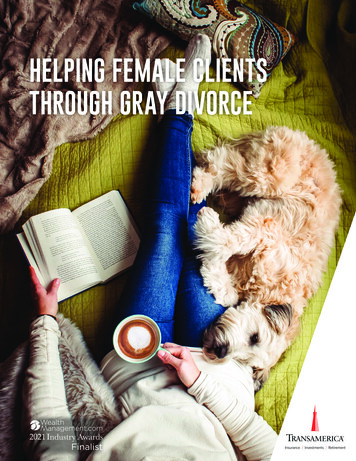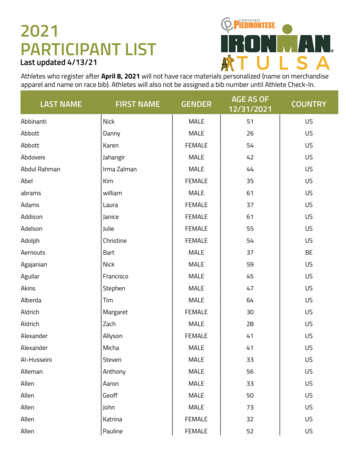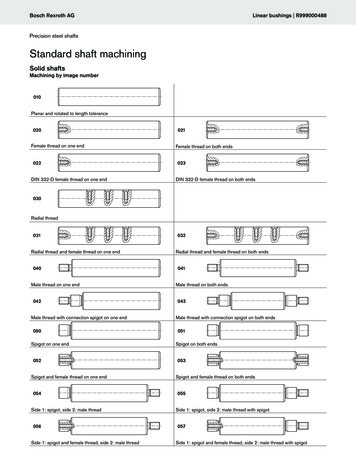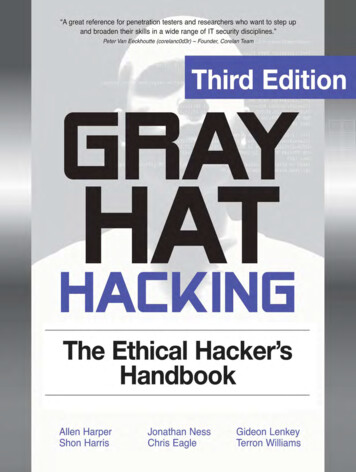
Transcription
HELPING FEMALE CLIENTSTHROUGH GRAY DIVORCE
HER UNCERTAIN FUTUREAS A SINGLE WOMAN IS IN YOUR HANDSDivorce over 50, also known as gray divorce, is becoming more common,with women mostly making the decision to separate. When a woman is goingthrough a gray divorce, her standard of living plunges 45%, meanwhile hermale counterpart sees his standard of living drop by a mere 21%.1About two-thirds of divorcesare initiated by women.” 2The rate of divorce after age 50 doubled in the U.S. after 1990,1 withapproximately 1% of married Americans over 50 getting divorced each year. 3The end of a decades-long relationship can create a financial and emotionalstrain, with complex issues coming to light. It’s important to note that the longera couple was together, the more time they had to amass complicated assetswhich are going from being a nest egg to needing to support two separateretirements, creating a grim outlook.Those getting a gray divorce canexpect their wealth to drop by 50%”– Divorce Destroys Finances of Americans over 50, Studies Show,by Ben Steverman, Bloomberg, July 19, 2019.While the financial impact on your client is likely extensive, the emotionalimpact of what she’s going through is also pivotal to understand as she’sexperiencing one of the most difficult times in her life right now.With proper guidance, you can help take some of the fear out of this processfor your client. In the following pages, you’ll find information about what she’sgoing through, how your empathy can result in a long-lasting relationship builton trust, and a framework to help you guide her.1Divorce Destroys Finances of Americans over 50, Studies Show, by Ben Steverman, Bloomberg, July 19, 2019.2“Women More Likely Than Men to Initiate Divorces, But Not Non-Marital Breakups,” American Sociological Association, August 22, 2015.3Divorce Is Costly. Divorce in Retirement Is Costly and Complicated. Barron’s article by Neal Templin, September 29, 2019.2
START YOUR JOURNEY TOGETHERNo two client experiences are going to be the same, however,there will be common themes that you’ll see as you workmore with women who are going through gray divorce.Use the scenario demonstrated below featuring your client,Diane, as your jumping off point. Adjust the conversation asnecessary to appropriately suit your client’s situation.Diane’s storyDiane and John have decided to end their marriage after 39 years together.The two were high school sweethearts, married at 20, and have twoadult children.This is where you step in as her financial partner and guide. You may havemet with John and Diane over the years, however this is a new chapter ofher life, and you’ll need to help her understand her new independence andhow to meet her financial goals.As you open the conversation up, you’ll be doing more listening thantalking. Divorce at any age can be a very emotional time, so it’s moreimportant than ever to seriously consider Diane’s thoughts and concerns.There’s a chance you’ll need to help her take the emotion out of thesituation, and guide her toward remaining objective.When the conversation shifts more toward finances, you’ll need to gaugewhere Diane is currently. By taking the initiative to sit down with you,she’s already starting the next phase of her life on her terms. Now, she’sexpecting you to be her coach to help her build her financial knowledge,while making sure she has the right tools to tackle her future. This isyour opportunity to assure her that this isn’t an end, but the beginning ofsomething new.The two of you should work together to get everything in order, at a pacethat she’s comfortable with. This way, the fear of rushing and making amistake is one less thing for Diane to worry about.Still, helping her navigate her finances may not be the only thing she needsright now. Not every client will be experiencing the same thing. However,if you feel she could benefit from additional contacts, you can fill out thelast page in this toolkit to give to her toward the end of your session. Ifyou feel she could use more than that, you could invite her to attend aworkshop you’re hosting where she can meet other women going throughsimilar experiences.Gestures such as these, as well as approaching conversations with patienceand empathy, will create a life-long professional relationship.3
YOUR CONVERSATION GUIDEYou know what information to give her, but first you need to establish a strongrelationship. Start with some of these questions and conversation starters toget to know your client.While discussing these questions, it’s important for both of you to rememberthat she’ll likely need to rethink her retirement timeline and plan because herjoint assets will now be supporting two separate retirements.How can I make this difficult process easier for you?Are you willing to share your greatest financial concerns with me?How do you envision your financial best-case scenario?Would you mind sharing your retirement priorities with me, so we can craft a plan within your means?Will you have access to healthcare post divorce?Do you have a complete inventory of your assets, debts, and expenses as a couple?Do you have individual assets, debts, and/or expenses?On a scale of 1–5, with 5 being very healthy, how would you rate the financial health of your householdprior to divorce proceedings?Why would you say you gave the rating that you did?On a scale of 1 to 5, with 5 being very knowledgeable, how would you rate your knowledge level andcomfort in dealing with your finances?Can you share with me why you gave this?What can I do to increase your comfort level and knowledge?Are there specific areas or topics on which you would like more information and help in increasingyour financial knowledge base?As we put together a timeline for decision making and a pre- and post-divorce financial plan,what items are most important to you?Are there people in your life that you help financially, such as a child, grandchild, or elder relative?Note: If your client lives in a community property state, ask her if she understands what that meansand the implications. If not, explain it to her. Boosting her financial education is essential right now.4
THE TRANSITION TO SEPARATE HOUSEHOLDSDetermining where she will live is one of the most difficult decisions your client must make.There are often strong emotions surrounding the home she and her spouse shared together.However, keeping it may not be a good financial decision for either party.Helping her make this decision by providing resources and financial guidance is essential to theprocess, as well as to the health of her financial future. Go through the situations below with heras she considers her options.Are her plans for her home to: keep, sell, downsize, rent, or move in with family?IF SHE’S PLANNING ON KEEPING THE HOME .If she’s not already the head of the household, she may need to: Change utilities to only her name Update the homeowner’s insurance policy and potentially shop for cheaper rates Change the title of the home once the divorce is final If she hasn’t already, see if homestead tax deduction is available through the county tax office Review services that she has: Is she happy with them? Is there an opportunity for cost reduction? Obtain, or make, a list of contractors she’s used for her home Agree on division of personal property as part of her divorce settlement Explore supplemental insurance options if she becomes ill and cannot pay the mortgageIF SHE’S NOT SURE ABOUT WHAT TO DO .Begin by letting her know that not selling could tie up a significant amount of assets.Here are some questions for her to consider: Based on the size and age of the home, what is the cost of upkeep? What is the property tax liability? Is there a mortgage on the house? Is there any equity or liquidity in the home? What is the cost of homeowner’s insurance? What are the homeowner’s association dues, if any?IF SHE’S DECIDED TO MOVE .Begin by letting her know that not selling could tie up a significant amount of assets. Go through the pros and cons of renting vs. buying Should she consider a temporary living arrangement before making a final decision? Help her understand the following about moving: Packing and hiring movers Going through her possesions Setting up her utility bills Evaluating whether she needs a storage unit5
YOUR QUICK REFERENCE SHEETSTEP 1:STEP 3: Your client is the most vulnerable she’s ever been.You need to establish an honest, open relationshipwith her based on trust. Ask open-ended questions and encourage her toopen up (see pg. 4).UNDERSTAND HOW SHE’S FEELING It’s important to listen more than talk. Once youstart working together, don’t shut her down or shyaway from her emotions. She might be feeling overwhelmed and emotional.Considering the volume of decisions she needs tomake, she may procrastinate out of fear of makinga mistake. Help her build a plan to make thingsmore manageable. She’s making decisions in all aspects of her liferight now. Segmenting what decisions need tobe made, and by when, can make this processmore manageable for her while boosting hercomfort levels.STEP 2:FRAME HOW THE CONVERSATION SHOULD GO Maintain eye contact, and find out what she is mostconcerned about right now. Encourage her to ask questions. Reaffirm thatthere are no stupid questions, and that you’ll answeranything she asks until she’s comfortable withmoving forward. Ask her if she minds you taking notes, and don’t beshy about reading information back to her to ensureyou haven’t missed anything. When appropriate, share stories of other clients whohave gone through similar experiences, and how youhelped them. Don’t be dismissive — resist the urge to tell her notto worry, or that you’ll take care of everything. Shelikely wants to be involved in the process so she has aline-of-sight into her finances.KNOW THE OTHER HALF OF THE EQUATION If you did not know her significant other:Ask her to share a story or characteristics aboutthem so that you can get to know them. If you did work with her significant otherpreviously:Ask her to share a memory so you can get toknow her better as well.STEP 4:UNDERSTAND WAYS YOU CAN SUPPORT HER Build your referral network of family lawyers, estatetax attorneys, CPAs, nutritionists, and more. Schedulemeetings with these professionals so they understandyour practice and experience. Host divorce workshops in financial education for yourrecently separated or recently divorced female clients.Invite other professionals in your network as well as anutritionist and/or stress management professional. Brand your practice and make your brand knownwith clients, on marketing materials, business cards,and more.6
FOR YOU, MY CLIENTAdditional resources can help you during this difficult time. Whether you’relooking for personal recommendations or want to do additional research onyour own, check out this list below.CPA OR ACCOUNTANTDIVORCE E NUMBER:PHONE NUMBER:FORENSIC ACCOUNTANTCOUNSELOR OR NE NUMBER:PHONE NUMBER:If you plan to go back to work after a period of not working,explore these connections to start your search: Experteer LinkedIn JobLeads Indeed Local employment agenciesOTHER RESOURCESBelow are general resources that can help you gain a better understanding of whatto expect from your finances during this time. Boost your financial education tohelp expand your comfort zone.Websites:Books:www.wiserwomen.orgLove Your Life, Not Theirs, 7 Money Habitsby Rachel �s Worthby Eleanor Blayney, CFPA Woman’s Road Map to Financial Well-Beingby Olivia Mellan and Sherry Christie7
When it comes to preparing for the future,there’s no time like the present.Let’s get started today.Visit: transamerica.comContact: 800-851-7555Transamerica Resources, Inc. is an Aegon company and is affiliated with various companies which include, but are not limited to, insurance companies and brokerdealers. Transamerica Resources, Inc. does not offer insurance products or securities. The information provided is for educational purposes only and should not beconstrued as insurance, securities, ERISA, tax, investment, legal, medical, or financial advice or guidance.Please consult your personal independent professionals for answers to your specific questions.Neither Transamerica nor its agents or representatives may provide tax or legal advice. Anyone to whom this material is promoted, marketed, or recommendedshould consult with and rely on their own independent tax and legal professionals regarding their particular situation and the concepts presented herein.Transamerica1801 California St., Suite 5200, Denver, CO 80202273826R1 2021 Transamerica. All Rights Reserved.09/21
3 Divorce Is Costly. Divorce in Retirement Is Costly and Complicated. Barron's article by Neal Templin, September 29, 2019. About two-thirds of divorces are initiated by women."2 Those getting a gray divorce can expect their wealth to drop by 50%" - Divorce Destroys Finances of Americans over 50, Studies Show,










